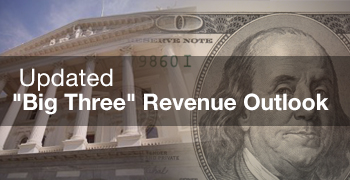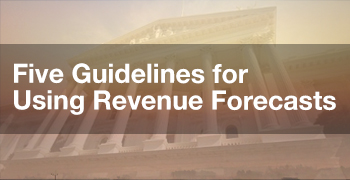
- All Articles 2016-17 State Budget
A Note on Economic Assumptions & State Budget Analyses May 15, 2016
We discuss the ways that economic assumptions affect state budget analyses and how policy makers and others should consider these assumptions.
April 2016 "Big Three" Tax Collections May 9, 2016
We have now received preliminary data from all the tax agencies concerning April 2016 collections of the personal income tax, the sales and use tax, and the corporation tax. These are the state General Fund's "Big Three" revenue sources.
April 2016 Tax Tracker: Personal Income Taxes May 5, 2016
Updated daily during April, this is our annual tracker page for California's personal income tax collections.
February 2016 State Revenues: Above Expectations...For Now March 10, 2016
We have received preliminary information from the state's tax agencies on February 2016 collections of the California's "Big Three" state General Fund taxes.
Administration's January 2016 Proposition 30 Estimates February 19, 2016
As part of the annual budget development process, the administration provides us with its current estimates of Proposition 30 revenues through 2018-19. 2018-19 is the last fiscal year affected by the Proposition 30 income tax increases for high-income Californians.
Personal Income Budget Formula Estimate Likely Too Low February 18, 2016
We discuss a particular formula used in the state budget related to personal income growth. The administration's January estimate of this formula for the 2016-17 state budget is likely too low.
Jan. 2015 Revenues: Income Taxes Modestly Under Projections February 12, 2016
We have received data on January 2015 state revenue collections from California's tax agencies.
A Closer Look at the Administration's Property Tax Estimates January 27, 2016
Our review of the best available evidence suggests that property tax collections in 2015-16 and 2016-17 will be higher than the administration assumes.
LAO Comment: Governor's Revenue Projections January 7, 2016
We provide a comment on the key tax revenue projections in the Governor's initial 2016-17 state budget proposal, which was released on January 7, 2016.
Fiscal Outlook: Personal Income vs. Income Tax Projections December 11, 2015
We discuss the distinctions between our personal income and personal income tax projections.
Fiscal Outlook: Property Taxes More Steady Than Home Prices November 18, 2015
Our Fiscal Outlook assumes continued growth in assessed values.
Fiscal Outlook: Proposition 30 Sales Taxes Expire At End of 2016 November 18, 2015
The expiration of the Proposition 30 sales tax increase affects the sales tax projections in our new Fiscal Outlook publication.
LAO Fiscal Outlook: Updated Proposition 30 Estimates November 18, 2015
In conjunction with the November 2015 edition of our Fiscal Outlook, we update our estimates for the revenue effects of Proposition 30 (2012).
Some Thoughts About Our New Fiscal Outlook November 18, 2015
A note discussing how we think of the scenarios in the new LAO Fiscal Outlook.
















